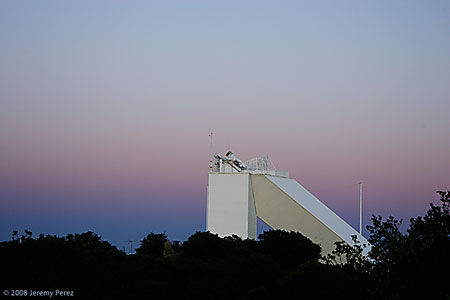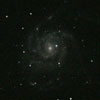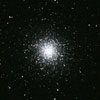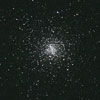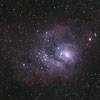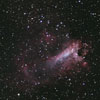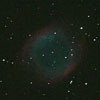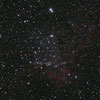On the evening of Sunday, June 8th, I had the pleasure of visiting Kitt Peak National Observatory and participating in the Advanced Observer’s Program–an overnight observing session with one of the program’s RC telescopes. I attended with four friends, Curt, Rob, Brazos, and Ken. Curt was the mastermind of the trip, and I had the privilege of being the tour guide. We were assisted all night by our friendly scope operator, John Zum Brunnen.
Because the five of us were attending a convention in Tucson, we weren’t able to get to the observatory until about 7:00 pm. That meant we missed the early dinner that normally goes along with the program. But we found John, and he showed us to our dorm rooms and then the cafeteria where we ate our midnight meals a few hours early. The cafeteria was nicely stocked, by the way, and the meals were great.
We were not able to head straight to our dome to observe, however. The way the program is structured, we needed to wait for the Nightly Observing Program to end at about 10 pm (since they use the AOP scopes to tour the NOP attendees). This wasn’t a big deal, since the five-day-old moon was lighting things up nicely. While we waited, I set up my 8″ Dobsonian and 15×70 Oberwerk binoculars for some casual observing at the Visitor Center patio. We shared the spot with a couple German visitors who had broken away from the NOP group to take some long exposures of the Milky Way rising over the striking National Solar Observatory to the east. We checked out some brighter objects such as M4, Omega Centauri, M8, M57, the False Comet in Scorpius, a squirming low-altitude Jupiter, and of course the Moon.
Before long, John showed up to lead us to the 16-inch RC dome. The scope was housed up a curving stairway at the top of a roll-off roof structure. It was spacious enough that the six of us easily fit with room to maneuver back and forth to the eyepiece. The 16-inch Ritchey-Chretien scope is well-suited for astrophotography, but we were there to enjoy visual observing: and it was excellent. Straining for detail through my 6-inch scope made galaxy details in the RC a delight–M51’s arms looked like a pair of sturdy ropes!
John pointed the scope for us by using a computer at one end of the room. Although the computer was operated in ‘dark’ mode, the light from the LCD display was still jarring each time he had to flip it on to re-point the scope. It would be nice if GOTO pointing could be handled with a small, dim hand controller. In the end, it wasn’t a big problem, since we weren’t really hunting extremely faint objects that would call for well-preserved dark adaptation.
The RC was paired with a TEC APO140ED (140 mm, f/7) refractor. For the first hour or so, we enjoyed comparing views through both scopes, but finally had John attach a Canon 20D to the refractor to snag photos of several objects as we observed them.
Here is a list of what we observed (they are only in rough chronological order):
| M51/NGC 5195 | Spiral structure was beautifully pronounced. With only a couple minutes of study, I could not convince myself that the “bridge” between the two galaxies appeared complete. |
| M101 | Spiral structure obvious, although still subtle |
| M104 | |
| M84/M86 and Pals | It was fun using the RC joystick to drive around the heart of the Virgo Cluster. NGC 4435 and 4438 showed tantalizing hints of structure that would have been nice to examine further. |
| M81/M82 | |
| M4 | |
| M13 | |
| M22 | |
| M27 | The fainter lateral extensions gave the nebula a very pronounced football shape. Beautiful. |
| M57 | |
| M11 | Bustling with stars. The dark lanes and v-shaped row of outer stars was very pronounced. |
| M8 | See this report |
| M20 | Dark nebulae were crisp and rich with detail. The reflection nebula wrapped itself noticeably around the periphery of the emission lobe. |
| M17 | Richly detailed with scalloping in the brighter portions and delicate feathering in the fainter sections. |
| M16 | More subtle than the previous three, but still loaded with mottling. Searching for the “Pillars of Creation” at 200X showed a very faint, dark intrusion shaped like a pointing hand at the right location. It would not have stood out without close examination of a drawing of the field. |
| NGC 6520 & B86 | Wonderfully detailed view with foaming Milky Way surrounding the cluster and dark nebula |
| M55 | |
| NGC 7789 | |
| NGC 6826 | Colorful, bright and detailed. |
| IC 3586 | PN does indeed possess the appearance of a slice of lime |
| Hickson 92 | The five brightest members all showed up nicely with just a bit of effort. |
| M31/M32/M110 | |
| NGC 7293 | Not much detail at a glance, but looked like it would benefit from some lengthy averted vision study. |
| NGC 7380 | Nebulosity surrounding the OC was elusive and the entire object would have benefited from a wider field. |
| Jupiter | Great detail, but no GRS or moon/shadow transits. |
| Uranus | Wonderful to see disc so well resolved and steady. |
| Neptune | Although smaller than Uranus, disc shape is a pleasant sight. |
And here are low-res images of the photos we took home with us:
I’m very slowly working my way through those photos to come up with optimized versions. But since each image is a single, three-minute exposure, eliminating noise is fairly difficult–and I’m no master at astrophoto processing. Still, for three-minute single exposures, they look really good to me. When I get them finished, I’ll post the processed versions…(so that you may laugh :-).
The program was very enjoyable, and it was great to see so many showpiece objects through an excellent scope. With five of us observing together, the cost came out to $182 per person. I think it would be nice to try the program again during the winter months to squeeze in a few more hours of darkness and linger on some more wonders of the deep sky.
Kitt Peak Advanced Observer’s Program: Highly recommended!
